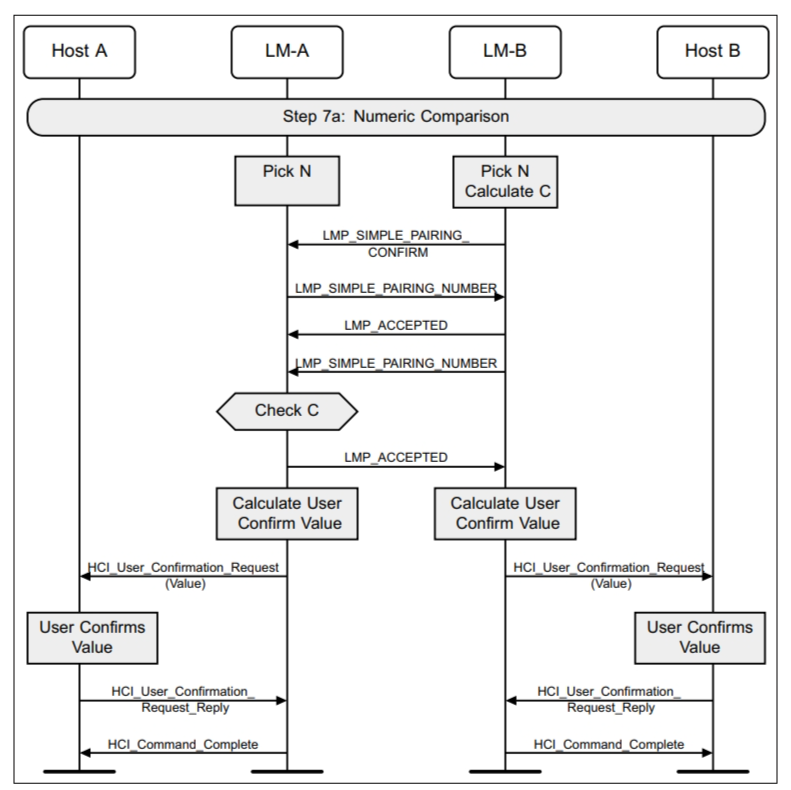
前言
大家在实际使用蓝牙时会发现,有些蓝牙设备配对需要输入配对码,有些蓝牙设备则会自动配对;那这些设备有什么区别,OpenHarmony的蓝牙协议栈又是怎么实现的呢?本文对此进行分析和解读。
蓝牙协议分析
SSP(SECURE SIMPLE PAIRING)时当前蓝牙协议中最推荐采用的认证配对方案;在SSP配对模式下,认证配对总体分为两步:IO Capability信息交换和用户确认。
IO Capability
蓝牙设备按照输入输出能力分为四类,以设备A作Initiator组合后认证配置方式如下表:
设备B\设备A | DisplayOnly | DisplayYesNo | KeyboardOnly | NoInputNoOutput |
DisplayOnly | 自动配对 | A用户确认,B自动配对 | B显示数字,A输入 | 自动配对 |
DisplayYesNo | A自动配对,B用户确认 | 用户确认 | B显示数字,A输入 | A自动配对,B用户确认 |
KeyboardOnly | A显示数字,B输入 | A显示数字,B输入 | 输入passkey | 自动配对 |
NoInputNoOutput | 自动配对 | B自动配对,A用户确认 | 自动配对 | 自动配对 |
交换设备IO Capability信息流程如下图:

MITM Protection
参考蓝牙core specification Version 5.4 | Vol 4, Part E, 7.1.29,可以发现IO Capability消息中除了IO_Capability字段还包括Authentication_Requirements字段,该字段同样影响设备配对流程。

man-in-the-middle(MITM) ,中间人攻击是一种常见的攻击手法,蓝牙SSP机制在用户确认模式时可以有效防止中间人攻击。
协议规定:如果两台设备都明确指定不需要进行MITM攻击保护,设备应该按照自动匹配流程处理。
用户确认

host收到User_Confirmation_Request消息后需要按照上表中的IO Capability要求用户确认或自动回复确认信息。
OpenHarmony实现流程
IO Capability信息交换
GapOnIOCapabilityResponseEvent函数处理对端设备的IOCapability信息,remoteAuthReq保存对端设备的认证要求;同时在ClassicAdapter模块保存对端设备IOCapability能力;这里比较奇怪的是IOCapability和remoteAuthReq分在两个模块保存。
确认处理
GapOnUserConfirmationRequestEvent函数获取到IO Capability交换流程中保存认证要求,并获取本设备最近一次连接的认证设置,作为参数传递到ClassicAdapter::SSPConfirmReq函数进行处理。
ClassicAdapter::SSPConfirmReq函数取出本设备及对端设备的IOCapability,调用CheckAutoReply函数结合认证信息进行最终的综合判断:如果是自动配对,则由ClassicAdapter::SSPConfirmReq调用UserConfirmAutoReply直接确认;否则向用户显示确认信息,要求用户确认。
总结
本文介绍了蓝牙协议中SSP认证配对过程及OpenHarmony中相关实现流程,蓝牙配对时是否会出现用户确认提示信息依赖两端设备能力,同时也依赖业务对安全性的要求;如果业务本身有其它传输加密能力,可以指定不认证方式进行连接,避免用户多次认证导致降低使用体验,如OpenHarmony软总线就是采用这种方式建立蓝牙连接。






































